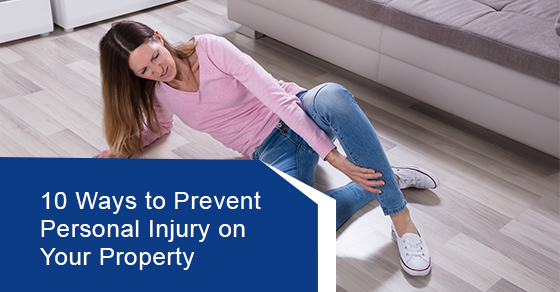
10 Ways to Prevent Personal Injury on Your Property
Posted by on Dec 10, 2021 in
As a property owner, you have a basic responsibility to take reasonable care to protect people inside or outside your home. Whether it is a slip and fall accident on your driveway because you failed to shovel the snow, or someone falling down the stairs inside your home because you don’t have proper banisters, if someone injures themselves on your property, you could be liable for damages. This can include not just medical bills, but also lost income and rehabilitation costs. With this in mind, not only should you make sure to have proper home insurance including liability, but also make certain you are reducing risk for accidents. Here are 10 ways to prevent personal injury on your property.
1. Keep an eye out for risks
The first rule of thumb is to keep an eye on your property for risks. Something as simple as a fallen branch or uneven ground can put people at risk of accidents. Understand that even if someone is on your property uninvited, they can still sue you for damage if they are injured due to your negligence. Some things you might not notice include:- Sharp or jagged edges on rusted handrails
- Loose objects such as paving stones or concrete steps
- Broken glass
- Broken or blown-out light bulbs
- Wasp nests
- Prickly weeds and poison ivy or oak
2. Beware of uneven surfaces
Uneven surfaces on your driveway and walkways can lead to accidents quicker than you might think. The slightest difference in levels on a pathway can make it easy for someone to trip. Thus, you should always repair the following as soon as possible:- Cracks in the walkway or driveway with a noticeable change in the surface level
- Uneven or missing paving stones
- Potholes in the driveway
- Areas dug up by animals
- Weeds growing between paved stones
- Rotting wood on steps and decks
3. General landscaping
If you have trees or large shrubs and bushes on your property, check them frequently for hanging or fallen branches, especially after high winds and storms. If a branch from a tree on your property falls and injures someone, you are liable for their injuries. As well, if someone were to trip on fallen branches, they could seek damages. You should also ensure your property is free of fallen leaves, which can be very slippery when wet. Raking the leaves in the fall and clearing away debris in the spring helps keep your property safe.4. Check outdoor stairways and ramps
Even a slightly uneven step can lead to accidents. As well, both stairs and ramps require handrails to hold onto outside. Stairs should be well-lit at night and be up to code to help reduce risk for accidents. Many homeowners are unaware that steps should be of one size and height, so people don’t suddenly step further down or up than expected. The treads should all be the same depth and not so narrow that it makes it difficult to step on it. Also, if you do have railings for stairs, make sure the supporting posts are safely spaced to reduce the risk for a small child getting their head caught and choking.5. Snow and ice
With the Canadian weather, we have to be diligent when it comes to clearing snow and ice. Depending on where you live, most areas have an 8-hour clearing law. Be sure you are following the laws in your area by shoveling snow, removing ice, and laying down some sort of slip-resistant material like road salt, ice-melt products, or sand.6. Follow local pool laws
Most areas have a law that swimming pools must be fenced with a locking gate. This can protect you from people entering your pool illegally, or small children from wandering onto your property and falling in. If you have a water feature or pond, you should also have a locked gate to your yard to prevent possible accidents. As well, your pool should have a non-slip deck surface to reduce risk for falls.7. Keep your interior floors safe
Floors are probably one of the riskiest areas for slips and falls in the home. When you have guests, be sure your floors are dry following mopping. Avoid using polishes that can make floors slick. Make sure your area rugs are secure with tape or non-slip backers. People can also trip due to uneven floors that transition from tile to wood, or carpet to hard surfaces, so make sure you point these dangers out. Also, buckles in wall-to-wall carpeting should be repaired so they are stretched and fitted properly. Clear away toys and other objects from the floor so nothing poses a risk for tripping.8. Keep your interior stairs safe
The same rules we mentioned for outdoor stairs apply to stairs inside the home. Be sure all of your stairs, including single steps in sunken rooms, have a handrail or banister. Wood stairs can be very slippery, so it is best to install a runner, or apply a non-slip paint or finish to reduce the risk of slips.9. Always hire fully insured home repair and renovation services
If you are having any kind of work done in your home, whether it is new floors, painters, carpet cleaners, or contractors, always hire fully insured services. Insured companies cover injuries that occur on the job. Uninsured companies could sue you for on-the-job injuries, property damage they cause or that occurs to their equipment, and other perils that might occur in your home.10. Other possible home perils
Some other risks you should keep in mind include:- Cords for blinds and window treatments that could injure a visiting child or pet
- Toxic substances not stored safely
- Disposing of toxic substances improperly
- Fire risks such as not having smoke detectors
- Mould
- Unsafe toys in the home
- Faulty electrical outlets that lead to shock

